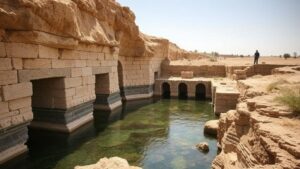Exploring the rugged interior of Central America for evidence of Toltec influence in Mayan cities.
Exploring the Rugged Interior of Central America for Evidence of Toltec Influence in Mayan Cities
The ancient civilizations of Central America, particularly the Maya and the Toltecs, offer a fascinating glimpse into the rich tapestry of Mesoamerican history. This article explores the rugged interior regions of Central America for signs of Toltec influence on Mayan cities, examining historical contexts, archaeological findings, and cultural exchanges that shaped these formidable societies.
The Toltec Civilization: An Overview
The Toltecs thrived in central Mexico from approximately 900 AD to 1168 AD. Considered a significant cultural predecessor to the Aztecs, their influence extended beyond their geographical boundaries. Established in the ancient city of Tula, the Toltecs are often associated with a warrior culture and extensive trade networks. Their artistic styles, particularly noted in stone carvings and architecture, have been documented remarkably well.
The Mayan Civilization: A Brief Historical Background
The Maya civilization, thriving from around 2000 BC to 1500 AD, spanned modern-day Mexico, Guatemala, Belize, and portions of Honduras and El Salvador. The Maya were known for their advanced understanding of astronomy, mathematics, and written language, with an intricate system of hieroglyphics. Major cities such as Tikal, Palenque, and Copán became prominent centers during the Classic period (250-900 AD).
Interconnections: The Evidence of Toltec Influence
Understanding the connections between the Toltecs and the Mayans requires examining both archaeological evidence and historical records. Notably, the post-classic period around 900 AD saw a shift in dynamics within Mesoamerica, leading to increased trade and cultural exchange. Several key aspects highlight Toltec influence on Mayan society:
- Architectural Styles: The matter of architecture provides essential evidence of Toltec influence. introduction of specific building styles, especially the distinctive columned structures seen at sites like Chichen Itza, is thought to reflect Toltec aesthetics.
- Artistic Motifs: Mesoamerican iconography saw a transition during the late post-classic period. Motifs such as the representation of warriors and jaguars, which were prevalent in Toltec art, began to appear in Mayan frescoes and sculptures.
- Religious Practices: The synthesis of gods and religious practices also indicates Toltec influence. Deities such as Quetzalcoatl found their way into Mayan worship, indicating a theological overlap.
Notable Archaeological Sites and Findings
Several archaeological sites in Central America underscore the interactions between these two vibrant cultures:
- Chichen Itza (Mexico): This iconic site showcases structures like the Temple of Kukulkan, which bears Toltec architectural influence with its pyramid style and serpent motifs.
- Copan (Honduras): The stelae and altars at Copan reveal stylistic elements attributed to Toltec craftsmanship, particularly in the depiction of rulers and deities.
- Tulum (Mexico): Situated on the Caribbean coast, Tulum reflects a mix of influences, particularly in its stone walls and temple reliefs that echo Toltec themes.
Implications of Toltec Influence
The influence of the Toltecs on the Mayan cities had lasting effects on Mesoamerican culture. This cross-pollination of ideas fostered a vibrant cultural landscape that blended artistic, architectural, and religious elements. It also hints at the complex socio-political dynamics of pre-Columbian civilizations, emphasizing the importance of trade networks and cultural exchanges.
Challenges in Establishing Links
Despite significant evidence of Toltec influence, establishing direct connections remains challenging due to various factors:
- Chronological Overlaps: The timeline of Mesoamerican cultures can overlap, making it difficult to ascertain exact influence and lead to debates among historians and archaeologists.
- Regional Variations: Different Mayan city-states exhibited varying degrees of influence, leading to a patchy understanding of cultural exchanges.
- Artifact Displacement: The looting of sites and excavation irregularities sometimes hinder precise attributions of specific artifacts or architectural features to either civilization.
Actionable Takeaways
For those interested in exploring the rugged beauty of Central America and uncovering the mysteries of these ancient civilizations, consider the following steps:
- Visit Archaeological Sites: Plan trips to key locations such as Chichen Itza and Copan to witness firsthand the evidence of cultural interplay.
- Engage in Research: Delve into academic publications and current research projects to gain deeper insights into ongoing discussions about Mesoamerican cultures.
- Participate in Guided Tours: Join expert-led archaeological tours that focus on the historical context of Toltec and Mayan relations to enhance your understanding and appreciation.
Exploring the rugged interior of Central America not only unveils the remnants of past civilizations but also deepens our understanding of cultural interconnections that shaped their legacies. By acknowledging the evidence of Toltec influence on Mayan cities, we weave a richer narrative of Mesoamerican history, recognizing the complexity and dynamism of its ancient peoples.



